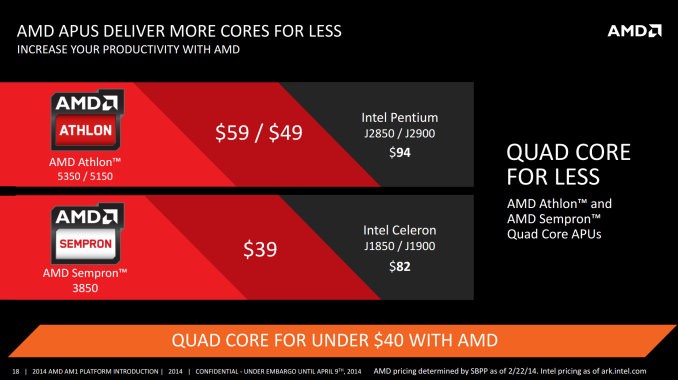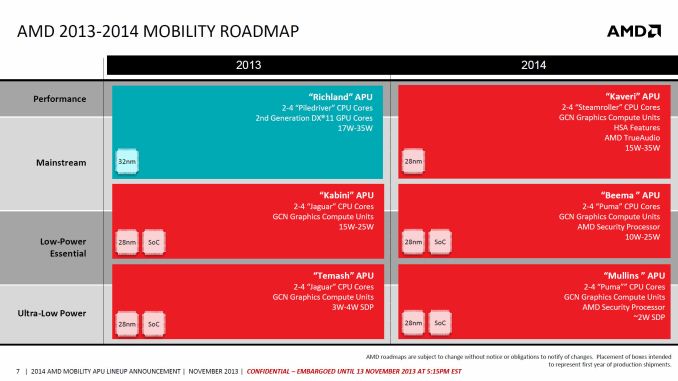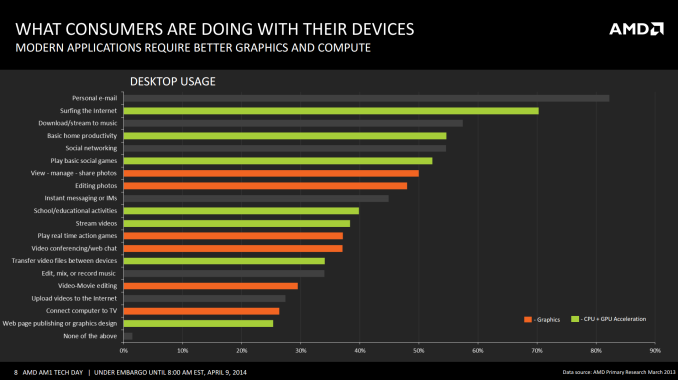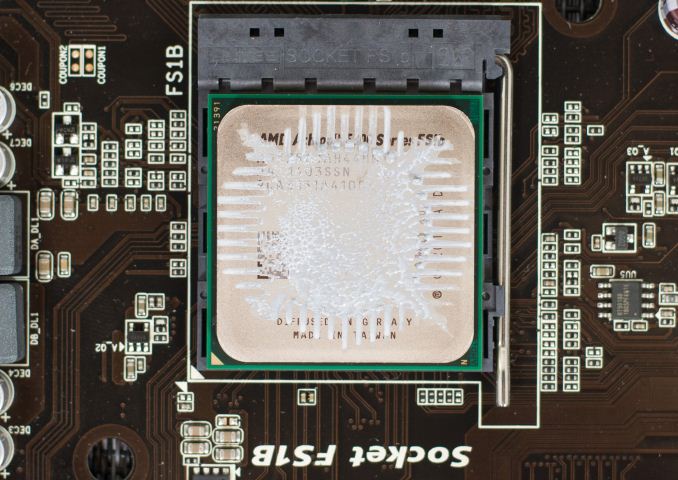The Desktop Kabini Review Part 1: AMD Athlon 5350 (AM1) Tested
by Ian Cutress on April 9, 2014 8:00 AM ESTFinal Words
As mentioned in our test setup, the benchmark results in this preliminary article are only a small fraction of our normal coverage. Due to other commitments we were unable to run every test on all comparison systems, but we have the other Athlon and Sempron APUs as well as comparable Intel counterparts coming in for review.
The poignant place to start with the final analysis is AMD’s claim of ‘Quad Core for Less’. In this statement alone, they are not wrong. Intel cannot provide a socketed quad core processor for less than $36 (Sempron 3850). The cheapest all-in-one desktop quad-core system from Intel equips the Celeron J1900 onto a motherboard for $92, which is exactly where AMD sit with the top-end Kabini based Athlon 5350 with a motherboard. One of the issues to consider at this point however is that Intel offers several dual core options (non-Atom) around this $40-$60 price point, and in many cases the IPC and CPU speed advantage of these cores is greater than that provided by Kabini, particularly in single threaded applications. The only downsides to this solution are the power consumption is higher, and the motherboards are more expensive. For a competitive socketed Intel dual core, a motherboard plus CPU can be in the region of $110-$120 at 35W-55W.
The big upside and selling point from the AM1 Kabini platform should be upgradeability. If a user buys an AM1 platform now, they should be able to upgrade it in the future. While AMD has not yet confirmed if Beema is coming to the socketed platform, the roadmaps suggest that the laptop sockets are remaining consistent from Kabini to Beema. This should imply that if Beema gets a socketed version, it should also remain based on AM1/FS1b.
If we compare single threaded performance between Kabini and our J1800 test system, the benchmarks are almost even between the two, particularly when it comes to synthetics such as Cinebench, but falls behind on emulation such as the Dolphin Benchmark and 3DPM. The integrated graphics of the Kabini pull ahead when it comes to gaming, despite the single channel memory interface.
|
AMD Athlon 5350 vs. Intel Celeron J1800 Single Threaded |
||
| Athlon 5350 | Celeron J1800 | |
| Cinebench R10 | 1967 | 1917 |
| Cinebench R11.5 | 0.51 | 0.49 |
| Dolphin Benchmark | 40.4 | 38.02 |
| 3DPM | 53.29 | 69.20 |
When placing Kabini against any Intel Ivy Bridge socketed processor, the increased IPC and frequency pushes the system above the Kabini, in exchange for more power and a more expensive system overall. If we compare the Kabini single-threaded results to those of the Celeron G465, a Sandy Bridge based single core CPU at 1.9 GHz, the Celeron does pull ahead on the majority, but fails miserably in the graphical benchmark suite.
|
AMD Athlon 5350 vs. Intel Celeron G465 Single Threaded |
||
| Athlon 5350 | Celeron G465 | |
| Cinebench R10 | 1967 | 2975 |
| Cinebench R11.5 | 0.51 | 0.73 |
| Dolphin Benchmark | 40.4 | 38.8 |
| 3DPM | 53.29 | 59.98 |
Does it seem particularly odd that a modern Kabini architecture at 2 GHz cannot keep up with a 3 year old Sandy Bridge processor at 1.9 GHz at our simple benchmarks? AMD is leveraging on the fact that much of what we do on a computer as a casual user can leverage the fixed function units of the graphics center of the APU:
AMD’s key in all of this is leveraging the GPU. For non-GPU intensive tasks, on paper, the J1900 for $92 and 10W TDP would seem to be the choice if upgradability is not a concern. The remit of AM1 and Kabini could be extended if motherboard manufacturers decided to use those extra PCIe lanes. Consider an AM1 with controllers to make a nice routing system (4x NIC) or something based around storage (SATA controllers and hubs). But because Kabini is also a cost play for AMD at the low-end desktop segment, margins are going to be ultra-tight for motherboard manufacturers and I do not imagine that as much effort will be put into making innovative products as the rest of their product range on other sockets.
In order for the upgradability angle to work, AMD need to keep the sockets around for at least two generations. AM1 comes late in Kabini’s life cycle, given that Beema on the mobile side is due out later in 2014. It would make sense for AMD to release Beema desktop parts, but the big question there is when. AMD could launch new processors on day 1 of Beema, or further into the life cycle. I would imagine that depends on what the competition does. AMD does have that advantage of having an upgradeable platform before Intel; however Intel may see the market differently. It is a hard one to judge.
Stay tuned for our full benchmark suite on the other AMD Kabini APUs.














126 Comments
View All Comments
MikeMurphy - Wednesday, April 9, 2014 - link
I'm excited to see this in an upgradeable NUC form factor.jardows2 - Wednesday, April 9, 2014 - link
Please, someone make a thin-mITX for this platform. This is going to be a limited use platform anyway, so there is no reason to put in the full gamut of I/O on the back.jabber - Wednesday, April 9, 2014 - link
Mmm vertically stacked and the size of a paperback book.But whats this...they put the VGA socket at the top! Noooooooooo!
No analogue audio out on the back, just at the front! Noooooooooo!
Yep seen that.
macs - Wednesday, April 9, 2014 - link
Sorry Anandtech but this is not a good review.Where is power consumption data? Comparison with Intel Haswell G1820 (really affordable Haswell chip)? Htpc quality? Older generation (amd e-350)??
Communism - Wednesday, April 9, 2014 - link
They put the newfangled AMD part in the best possible light since they can't afford AMD to be mad at them since AMD pays the bills :PDoes make the a mockery of this Article that it doesn't even include the Intel Haswell G1820 that is it's real competition.
MSRP Intel Haswell G1820 is 42 USD
You can get an H81 board for 49 USD
You can also have real upgradability, since you can go up to a 4670 if you want to.
CiccioB - Wednesday, April 9, 2014 - link
I agree, having a sponsored section on the site isn't really a best thing to avoid any suspicion about bias or favouritism. Any glitch in a review can be seen as a favour to the sponsor. And none will ever know if that's true or not.BTW, I have an Atom D510 (dual physical cores with HT) ITX server which is on 24/24 7/7 used for P2P, backup and some script, stotage and database server. No GFX capacity needed (it is connected to the main PC through Remote Desktop thus "sharing" one of the monitors).
What would be the best solution to replace it if it will eventually die tomorrow?
That Pentium J1800@10W seems very good. Is there something better than that? Consider that power consumption and related fan noise are critical, being always on in my bedroom.
macs - Wednesday, April 9, 2014 - link
I have a similar setup with an AMD e350 itx board. I'm trying to understand if I should upgrade to a newer platform but this review didn't help.Main concern is power consumption, it would be interesting comparing Kabini, BayTrail D and low end Haswell
Communism - Wednesday, April 9, 2014 - link
I can understand not doing the Power Consumption tests, since their standard benching platforms are "Enthusiast" and "Overclocking" motherboards, resulting in higher power consumption of the boards masking the true TDP of the CPU/GPU as a result of the additional chips on the board adding other functionality.They would have to use very sparse basic boards to make the comparison anywhere close to realistic.
jospoortvliet - Thursday, April 10, 2014 - link
Reviews on other sites show AMD consistently beating baytrail at virtually the same active power envelope and much lower idle. Baytrail offers no advantage whatsoever so you can cross that off the list already 😎Beany2013 - Wednesday, April 9, 2014 - link
Try reading the article rather than just looking at the pretty pictures:"As mentioned in our test setup, the benchmark results in this preliminary article are only a small fraction of our normal coverage. Due to other commitments we were unable to run every test on all comparison systems, but we have the other Athlon and Sempron APUs as well as comparable Intel counterparts coming in for review."
Also, the title - Review *Part 1*.
More numbers, compared to competing parts from intel, will be upcoming. It says it in the article - at least twice. It's not ATs problem if you weren't gifted with the good grace to actually read an article before accusing the author of being a shill/being biased/being on the payroll.
Steven R